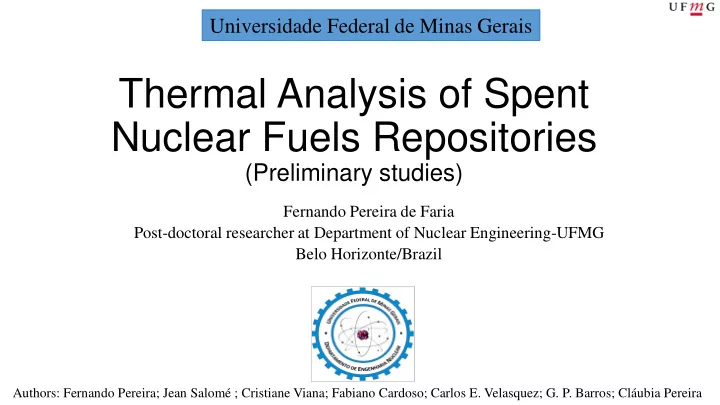

Universidade Federal de Minas Gerais Thermal Analysis of Spent Nuclear Fuels Repositories (Preliminary studies) Fernando Pereira de Faria Post-doctoral researcher at Department of Nuclear Engineering-UFMG Belo Horizonte/Brazil Authors: Fernando Pereira; Jean Salomé ; Cristiane Viana; Fabiano Cardoso; Carlos E. Velasquez; G. P. Barros; Cláubia Pereira
Present context of radioactive waste forms in Brazil
Brazilian power supply – 2015 2,3% 1,2% 4,0% 8,4% 5,9% 1,4% 5,2% 62,5% 9,1% Hydro Biomass Wind+Solar Nuclear Oil Natural Gas Coal Industrial Gas Importation Extracted from official data of governement : Free online access in: www.mme.gov.br
Brazilian nuclear power plants ANGRA 2 ANGRA 1 ANGRA 3 Operating since 2001 Operating since 1985 Under construction Electrical power: 657 MWe Electrical power: 657 MWe Electrical power: 1405 MWe Refueling: ~12 months Refueling: ~12 months Refueling: ~12 months 121 elements of UO 2 fuel 193 elements of UO 2 fuel Nuclear Central Almirante Álvaro Alberto – Angra dos Reis – Rio de Janeiro
Management of radioactive waste forms in Brazil 3 appropriate hangars Low and intermediate with capacity until 2025 radioactivity level wastes ANGRA 1 – 935 elements Dry storage ANGRA 2 – 787 Capacity After under elements Spent nuclear fuel Pools consideration 2021 Expected to be fully filled ANGRA 3 – 1084 in 2021 elements Final repository: Geological disposal?
Thermal analyzes in progress at DEN/UFMG on storage Spent Nuclear Fuel (SNF)
Advanced nuclear systems under study at DEN • Fusion Fission System (FFS) SNF reprocessed by UREX+ process and spiked with thorium • Accelerator Driven Systems (ADS) SNF reprocessed by GANEX process and spiked with thorium • Very high-temperature gas-cooled reactor (VHTR) SNF reprocessed fuel by UREX+ process and spiked with thorium • Gas-cooled Fast Reactor (GFR) SNF reprocessed fuel by UREX+ process and spiked with thorium
SNF properties Spent Fuel Enrichment Burnup Operation time Final amount of fissile material UO 2 – From PWR 3.2 % 33 GWd/tHM 3 yr 1.46 % UO 2 – From VHTR (1) 15.5 % 90.2 GWd/tHM 3 yr 9.2 % *(Th,TRU)O 2 - From 15 % 97.8 GWd/tHM 3 yr 8.05 % VHTR **(Th,TRU)O 2 – 12 % 2.376 x 10 12 20 yr 2.04 % From ADS (2) GWd/tHM (1) Very High-Temperature Reactor; (2) Accelerator-Driven Subcritical Reactor System *Obtained from UREX+ reprocessed technique. ** Fuel consisting mainly of transuranic obtained from GANEX reprocessed technique. These SNFs are being studied under wet storage and under geological disposal conditions
SNF decay heat profiles • Essential for specifying the heat sources. • Obtained from Origen2.1 code studies.
Geometry considerations • Spent Fuel Pool simulated (SFP): Pool dimensions: (0.56 x 0.56 x 5) m with 1/4 of its effective volume filled with SNF. SF amount stored: 4 cylinders of 8.8 cm of radius and 4m of height spaced 18.8 cm center-to-center.
Modeling The problem: How long the water Reactor No external cooling Storage at SFP takes to reach the Question discharge system at t =0 and t =10 yr boiling for initial cooling temperature? starting from the fuel discharge Characteristics of heat sources • The knowing of the heat fluxes at the cylinder surfaces ρ fuel Decay heat values at t =0 and W/m 2 units t =10 yr in W/tHM units Total surface area (Simulation requirement) (Origen2.1 results) of cylinder
Modeling Implementation • Via the computational fluid dynamics package ANSYS CFX, based on finite elements method. The geometry mesh
Modeling Techniques 1 – ( Open-top ): Allows the heat transfer between the SFP and the environment. 2 – (S ealed-walls ): All the SFP walls set as adiabatic, and the fraction of water and air fixed at 0.95 and 0.05, respectively.
Modeling Materials physical properties and heat fluxes required • For Water and Air Molar mass, density, temperature, pressure, specific heat capacity, dynamic viscosity and thermal conductivity.
Results Increasing water temperature rate ( R T ) of the SFP in °C/s, and boiling time of water ( T b ) t = 0 yr t = 0 yr t = 10 yr t = 10 yr Spent Fuel types Spent Fuel types sealed-walls open-top sealed-walls open-top R T ; T b R T ; T b R T ; T b R T ; T b VHTR-UO 2 0.031; 32.3 min 0.027; 37 min PWR-UO 2 5.863x10 -4 ; 28.4hr 5.151 x10 -4 ; 32.4hr PWR-UO 2 0.086; 11.6 min 0.074; 13.5 min VHTR-UO 2 0.0023; 7.25 hr 0.0019; 8.8 hr ADS-(Th,TRU)O 2 0.145; 7 min 0.125; 8 min VHTR-(Th,TRU)O 2 0.0108; 1.54 hr 0.0092; 1.8 hr ADS-(Th,TRU)O 2 VHTR-(Th,TRU)O 2 0.422; 2.4 min 0.359; 2.8 min 0.0110; 1.5 hr 0.0095; 1.75 hr The sealed-walls and open-top values differ by less than 16%. 1/ T q b
Results
Geological repository concept Swedish KBS-3V concept. PWR disposal canister design (Nirex Ltd., 2005).
Ansys geometrical modeling
Modeling description • It was used the Ansys transient thermal module. • The four PWR fuel assemblies were represented by a parallelepiped with the real height of the fuel assembly.
Modeling description • Ansys quantity: Internal heat generation , in W/m 3 . Fitting using a first-order exponential function with t in seconds.
Modeling description Density (kg/m 3 ) Material Thermal Conductivity Specific heat (J/kg °C) (W/m °C) PWR SF 9870 0.135 2640 Cast iron insert 7200 52 504 Cooper Canister 8900 386 383 Bentonite 1970 1 1380 Backfill 2270 3.2 1190 Rock 2650 3.2 815 Data from Choi, 2008; Lee et al., 2010. Thermal gradient along the vertical layer of rock: 30°C/km
Results Temperature as a function of time on a PWR canister surface.
In progress … • Studies of spacing between canisters for PWR, VHTR and ADS spent fuels. Acknowledgment • To the CNEN (Comissão Nacional de Energia Nuclear), CNPq (Conselho Nacional de Desenvolvimento Científico e Tecnológico), CAPES (Coordenação de Aperfeiçoamento de Pessoal de Nível Superior) and FAPEMIG (Fundação de Amparo à Pesquisa do Estado de Minas Gerais), for the support to this work. • To the ICTP for the financial support of my participation on this workshop
Recommend
More recommend